A samovar is a metallic vessel used for boiling water and making tea.
In Russia, the first samovars appeared with the spread of tea drinking. Historical records indicate that the city of Suksun was the first to produce samovars. A 16-pound tin-plated copper samovar manufactured at the Suksun factory was mentioned in documents from 1740. Historians found the first reference to the Tula samovar in a document from 1746. Some believe that samovar production was launched simultaneously in two cities, as factories in Suksun and Tula belonged to Russian entrepreneurs from the Demidov dynasty.
Samovar manufacturing proved to be highly profitable: artisans quickly became manufacturers and workshops were turned into factories. Samovars varied in shape (vase-like, pear, and others) and size (ranging from three to 15 liters in volume). The price of these unique devices was determined by their weight. The heavier a samovar was, the more it cost.
In fiction, there are many descriptions of samovars
and the atmosphere of tea drinking. For example, in the story “Shlisselburg
Station” by Nikolay Alexandrovich Bestuzhev, one can read the following,











